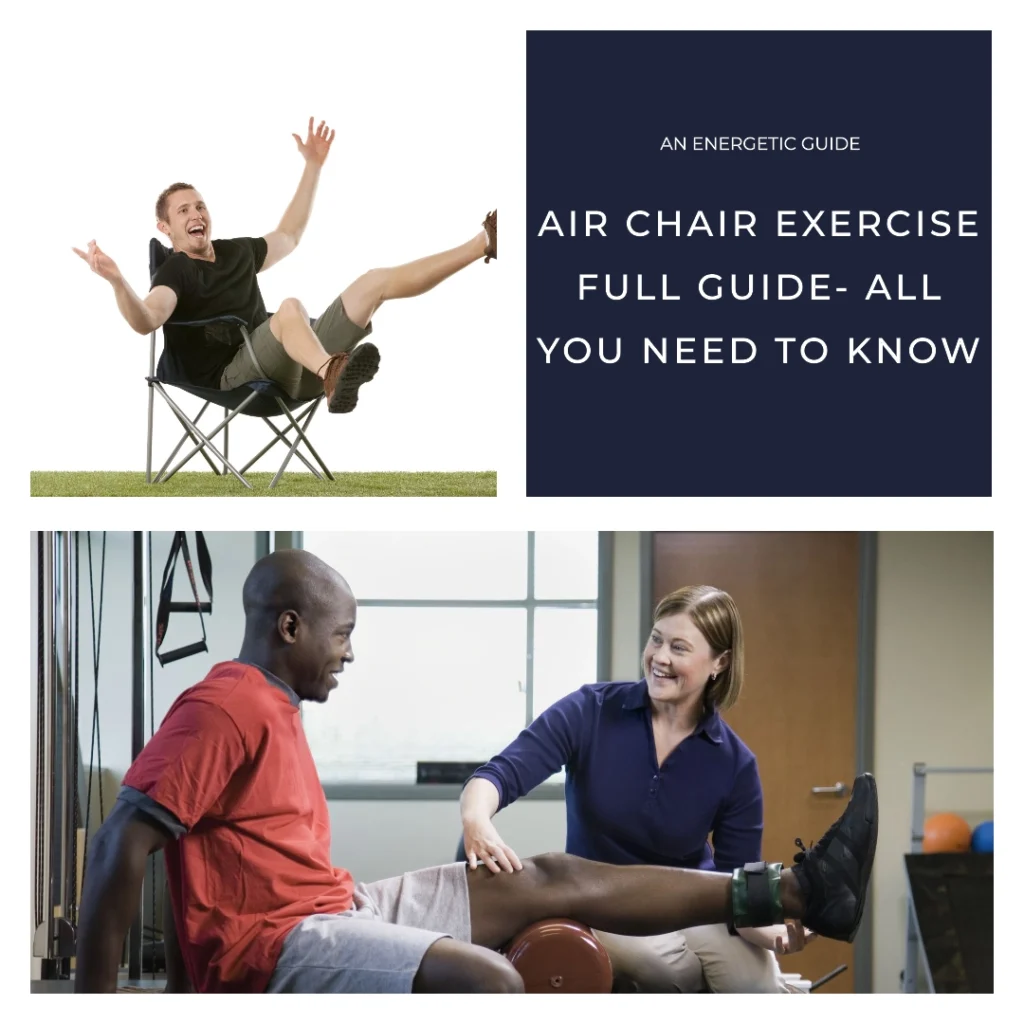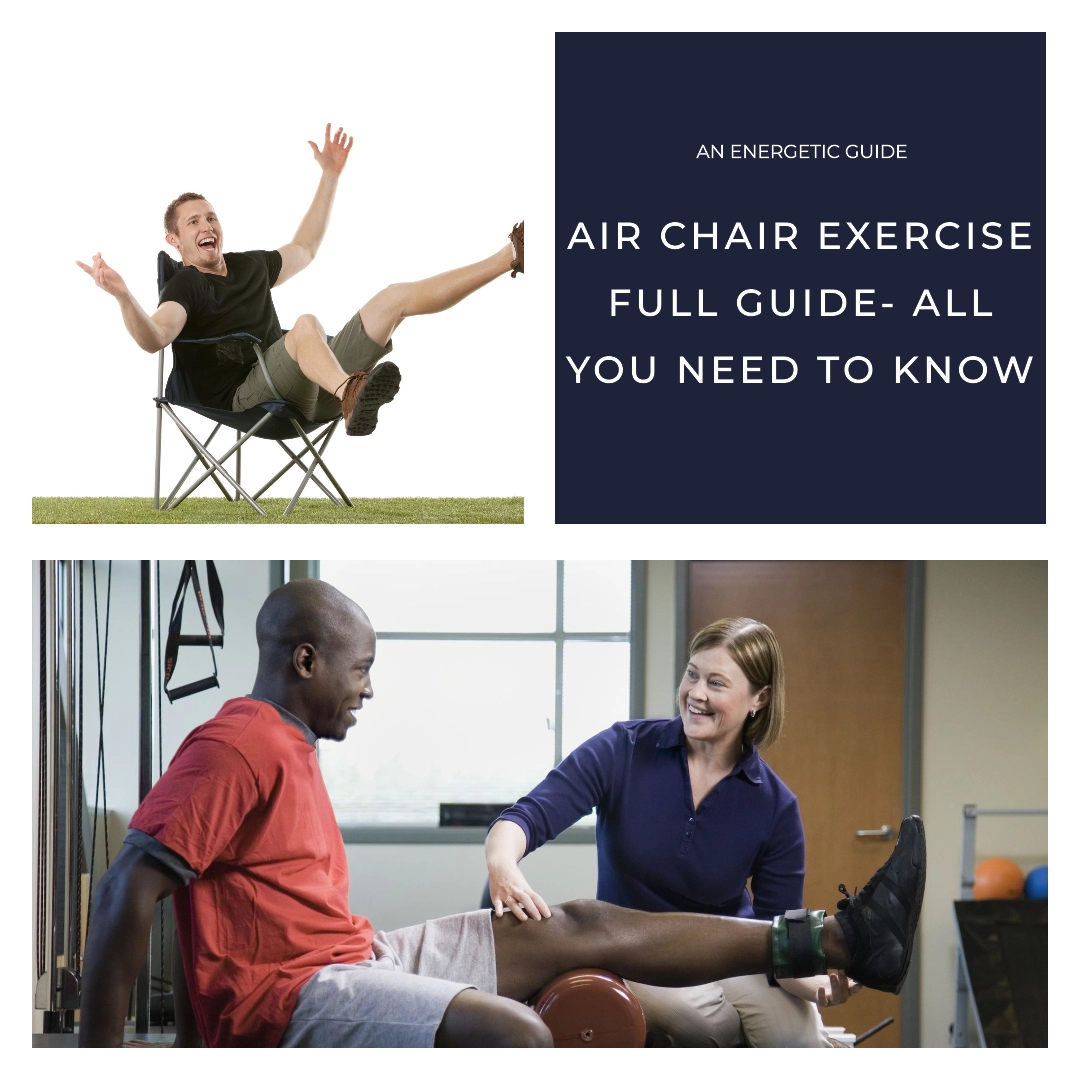The air chair exercise is a form of isometric exercise that engages the whole bodyweight by simulating the act of sitting in an imaginary chair. Despite not requiring an actual chair, this active sitting exercise provides an effective bodyweight training routine that can be performed without any equipment. It involves a static hold exercise that targets multiple muscle groups, making it a comprehensive no-equipment workout.
The air chair is a versatile exercise that offers numerous benefits. It helps improve good posture by strengthening the core muscles responsible for maintaining proper spinal alignment, potentially alleviating back pain. This exercise can be incorporated as a movement snack throughout the day, serving as a proactive, preventive measure against the adverse effects of prolonged sitting.

The benefits of air chair exercise
Maintaining good posture is crucial for overall health and well-being. The air chair exercise can help correct poor posture by strengthening the core muscles that support the spine. This exercise can also alleviate back pain by reducing strain on the lower back muscles and promoting proper spinal alignment.
All exercises have their benefits, and air chair exercise isn’t different from that. The benefits of air exercise are-
- It’s a full-body workout. That means air chair exercise can impact your whole body.
- The air chair exercise is beneficial for your cardiovascular health.
- It helps with muscle toning.
- Beneficial to prevent arthritis and joint pain.
- Improve neck, back, and hip pain.
- Air chair exercise is beneficial for constipation and lower body parts.
- Rearrange the shape of core muscles.
- Burns calories.
- Relieves from chronic pain.
- Suitable for young people, people in middle age, and also old people.
The benefits of air chair exercise, therefore, encompass a broad spectrum of physical and mental health advantages. Its integration into a regular fitness regimen can lead to profound improvements in overall well-being, highlighting the exercise’s significance in a balanced and holistic approach to health.
Note: Children under 12 years old are discouraged from practicing air chair exercise.
Airchair squat benefits
Performing bodyweight squats, such as the air chair exercise, offers numerous benefits for leg strength and overall lower body development. This exercise targets the quadriceps, hamstrings, and glutes, making it an effective compound exercise that engages multiple muscle groups simultaneously.
The air chair is considered a leg similar exercise to traditional squats, as it mimics the same movement pattern without the added weight. This makes it an ideal exercise for beginners or individuals recovering from injuries, allowing them to practice proper squat form in a movement rich environment without excessive strain.
Incorporating air chair squats into your routine can significantly improve lower body strength, balance, and stability. Additionally, this exercise can enhance overall functional fitness by replicating movements commonly performed in daily life, such as sitting down and standing up from a chair.
The types of air chair exercises
There are several variations of the air chair exercise, each targeting different muscle groups and offering unique challenges:
- Air squats: This basic variation involves simulating the motion of sitting down and standing up from an imaginary chair. It primarily targets the legs, glutes, and core muscles, making it an excellent exercise for developing squat position and overall lower body strength.
- Form 1 chair: This variation involves raising one leg off the ground while holding the air chair position, increasing the challenge and engaging additional stabilizing muscles.
- Stability ball: By incorporating a stability ball into the exercise, you can challenge your balance and core stability while performing the air chair movement.
- Lsit bridge: Combining the air chair with a glute bridge targets the hamstrings, glutes, and lower back muscles, providing a comprehensive lower body workout.
- Sidereclining leg lift: This variation targets the oblique abdominal muscles by performing the air chair movement while lying on your side, challenging your core stability and strength.
In summary, the types of air chair exercises offer a rich palette of options for individuals seeking to enhance their fitness routine. From strengthening and stabilizing the core to improving balance and flexibility, these exercises provide a comprehensive approach to fitness that can be tailored to suit a wide range of goals and preferences. As we continue to explore and innovate within the realm of fitness, the air chair concept stands as a testament to the power of simplicity, creativity, and adaptability in achieving a healthy and balanced lifestyle.
Utkatasana (Yoga chair pose)
Utkatasana, often referred to as the Yoga Chair Pose, elegantly integrates the principles of balance, strength, and endurance into a singular, impactful posture within the realm of air chair exercises. This ancient yoga asana transcends mere physicality, delving into mental and spiritual realms, thus offering a holistic approach to wellness. It aligns seamlessly with the foundational elements of air chair exercises, emphasizing the use of the body’s weight to enhance fitness and well-being.
Practicing Utkatasana requires a blend of focus, strength, and flexibility. The pose, mimicking the act of sitting in an invisible chair, demands significant lower body strength, specifically targeting the thighs and calves while engaging the core and back muscles to maintain balance and posture. This comprehensive muscular engagement not only strengthens the body but also promotes improved joint health and mobility. The requirement for comfortable and stretchable clothing during practice underscores the need for freedom of movement, allowing practitioners to fully engage in and benefit from the pose.
The benefits of Utkatasana extend beyond the physical. The pose challenges practitioners to maintain focus and balance, fostering a sense of inner calm and concentration. This mental engagement is a crucial aspect of yoga, reflecting the practice’s emphasis on the mind-body connection. As individuals hold the pose, they develop not only physical endurance but also mental resilience, learning to navigate discomfort and maintain composure.
Moreover, Utkatasana serves as a foundational pose within the broader spectrum of yoga, preparing practitioners for more advanced asanas by building essential strength and flexibility. Its accessibility to beginners makes it a valuable entry point into yoga, while the potential for variations and increased intensity keeps it relevant for more experienced yogis. This adaptability ensures that Utkatasana remains a cornerstone of yoga practice, offering benefits to a wide range of practitioners.
Deku air chair exercise
The Deku air chair exercise, inspired by the dynamic movements seen in anime, brings a fresh and innovative approach to traditional fitness routines. This particular exercise merges the creativity and imagination often found in anime with the physical discipline required in exercise, creating a unique workout that is not only effective but also engaging and fun. The exercise targets the core, enhancing strength, flexibility, and balance, while also promoting cardiovascular health through its dynamic movements.
First and foremost, the Deku air chair exercise requires participants to adopt a stance that is both stable and flexible, embodying the resilience and agility of anime heroes. The exercise involves standing with one foot slightly behind the other, shifting the body’s weight back and forth in a controlled manner. This movement pattern challenges the balance and engages the core muscles intensely, mirroring the dynamic poses and actions characteristic of anime characters. The inclusion of imaginary scenarios or challenges, akin to those faced by characters in anime, can add an element of mental engagement to the workout, making it more enjoyable and mentally stimulating.
One of the key benefits of the Deku air chair exercise is its ability to strengthen the core muscles comprehensively. A strong core is essential for overall body strength, stability, and injury prevention. By focusing on core engagement in a dynamic and fun way, this exercise appeals to a wide audience, including those who might not be motivated by traditional workout routines. Furthermore, the cardiovascular aspect of the exercise, driven by the continuous movement and balance shifts, contributes to heart health and endurance building.
The Deku air chair exercise also offers significant flexibility in terms of intensity and complexity. Participants can adjust the speed, range of motion, and duration of the exercise to match their fitness level and goals. This adaptability makes it suitable for beginners looking for an accessible entry point into fitness, as well as for experienced individuals seeking to add variety and challenge to their routines. Additionally, the exercise can be performed without any equipment, emphasizing the accessibility and convenience of incorporating anime-inspired workouts into one’s fitness regimen.
Airchair squat exercise
The air squat exercise is a fundamental variation of the air chair movement, focusing primarily on leg strength and proper squat form. It can be easily incorporated into various air squat workout routines, making it a versatile addition to any fitness regimen.
To perform the air squat exercise, stand with your feet shoulder-width apart and your arms extended in front of you for counterbalance. Engage your core muscles and send your hips back as if sitting into an imaginary chair, ensuring that your knees stay behind your toes throughout the movement. Pause briefly at the bottom of the squat, then press through your heels to return to the starting position.
One of the common air squat mistakes to avoid is allowing your knees to cave inward, which can lead to improper knee tracking and potential injury. It’s also essential to maintain an upright torso and avoid rounding the back or leaning too far forward or backward.
In conclusion, the airchair squat exercise represents a fusion of traditional strength training with innovative fitness techniques, offering a comprehensive workout that challenges the body in new and effective ways. By emphasizing proper form, isometric strength, and functional movement, it serves as a valuable addition to any fitness regimen, promoting improved lower body strength, endurance, and overall physical health. As individuals continue to seek out exercises that are both effective and adaptable, the airchair squat stands out as a versatile and rewarding option, exemplifying the potential for creativity and innovation in the pursuit of fitness and well-being.
Chair push-up exercise.
The chair push-up exercise ingeniously adapts the traditional push-up to increase accessibility and introduce variability to upper body workouts. By incorporating a chair, this exercise elevates the push-up, literally and figuratively, adding a new layer of intensity and focus on the chest, shoulders, triceps, and core muscles. This modification not only diversifies the push-up but also makes it accessible to a wider range of fitness levels by allowing adjustments in intensity based on the chair’s height and stability.
Initiating the chair push-up involves placing your hands on the seat of a sturdy chair, wider than shoulder-width apart. This positioning leverages gravity to increase resistance, especially as you lower your body towards the chair, intensifying the workout for the upper body muscles. The elevation provided by the chair also allows for a deeper range of motion compared to standard push-ups, further challenging the muscles and enhancing strength and flexibility.
One significant advantage of the chair push-up is its contribution to correcting common push-up mistakes. The elevated platform ensures better alignment of the spine and allows for a fuller extension of the arms, promoting proper form and reducing the risk of injury. Additionally, this variation encourages engagement of the core throughout the exercise, ensuring a comprehensive workout that extends beyond the upper body to include vital core strengthening.
The chair push-up exercise is also an excellent option for those looking to build upper body strength without access to a gym. Its simplicity and the minimal equipment requirement make it an ideal exercise for home workouts, demonstrating that effective strength training can be both accessible and convenient. Furthermore, for individuals at advanced fitness levels, the exercise can be modified to increase difficulty, such as by elevating the feet on another chair, thus continuously challenging the muscles and preventing plateauing.
In summary, the chair push-up exercise embodies the innovative spirit of contemporary fitness, offering a versatile, effective, and accessible option for strengthening the upper body. By emphasizing proper form, adaptability, and functional fitness, it presents a valuable addition to any workout regimen, catering to a broad spectrum of fitness enthusiasts from beginners to advanced practitioners. As fitness continues to evolve, exercises like the chair push-up exemplify the ongoing search for creative solutions to traditional workout challenges, fostering a more inclusive and adaptable fitness culture.
Do’s and don’ts of air chair exercise
Navigating the practice of air chair exercises requires a blend of enthusiasm, discipline, and caution to maximize benefits while minimizing risks. These exercises, celebrated for their versatility and efficacy, also demand a thoughtful approach to ensure safety and effectiveness. Below are essential do’s and don’ts, providing a roadmap for both beginners and seasoned practitioners to follow, ensuring a productive and enjoyable workout experience.
Do’s of Air Chair Exercise
- Wear Appropriate Clothing: Opt for comfortable, stretchable, and breathable attire that doesn’t restrict movement or cause discomfort during exercise. Proper footwear (or the decision to go barefoot for certain exercises) should also be considered based on the exercise environment and personal comfort.
- Focus on Good Posture: Prioritize maintaining a neutral spine and proper alignment throughout each exercise. This not only enhances the effectiveness of the workout but also prevents strain and injury. Exercises like the air chair squat are particularly beneficial for reinforcing good posture.
- Use a Stability Ball for Added Challenge: Incorporating a stability ball can intensify the workout by engaging more muscle groups and improving balance. For example, placing the ball against a wall and leaning into it during squats can add stability and resistance.
- Embrace Active Sitting: When not actively exercising, consider using an ergonomic chair or sitting on a stability ball to maintain core engagement and promote better posture. This practice, known as active sitting, complements the benefits of air chair exercises.
- Incorporate Movement Snacks: Short, frequent bouts of physical activity, or “movement snacks,” can be highly beneficial. Simple stretches, standing from a seated position without using hands, or performing a few air squats can invigorate the body and improve circulation during long periods of sedentary activity.
Don’ts of Air Chair Exercise
- Avoid Rushing into Advanced Moves: Gradually progress to more challenging exercises to avoid overexertion and injury. Recognize your body’s current limits and incrementally push those boundaries with mindful practice and patience.
- Don’t Neglect Warm-ups: Jumping into intense exercises without proper warm-up can strain muscles and joints. Start with light stretches or low-intensity movements to prepare the body for more strenuous activity.
- Avoid Holding Your Breath: Ensure to breathe steadily and deeply during exercises. Proper breathing not only oxygenates the muscles but also supports core engagement and stability.
- Don’t Ignore Pain: Listen to your body and differentiate between the discomfort of muscle fatigue and the pain of strain or injury. If an exercise causes pain, stop immediately and assess if adjustments are needed.
- Avoid Inconsistent Routines: While flexibility in workout schedules is necessary, inconsistency can hinder progress. Aim for regular practice to build strength, flexibility, and endurance effectively.
Following these do’s and don’ts can significantly enhance the experience and outcomes of engaging in air chair exercises. By adhering to these guidelines, individuals can enjoy the myriad benefits these exercises offer, from improved strength and posture to enhanced mobility and overall well-being, all while keeping safety and personal progress in focus.
Conclusion
The air chair exercise is a versatile and accessible addition to any fitness routine, offering numerous benefits for overall strength, stability, and posture. By incorporating the various variations and adhering to proper form and technique, you can create a fitness journey that promotes workout consistency and exercise motivation.
Remember to set achievable goal setting and track your progress tracking regularly. Consistency and perseverance are key to developing a habit formation that will lead to long-term success in your fitness endeavors.
Whether you’re a beginner or an experienced fitness enthusiast, the air chair exercise can be tailored to suit your individual needs and preferences. Embrace the challenge, stay committed, and enjoy the journey towards a stronger, healthier, and more confident you.

